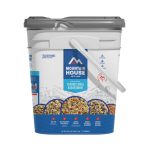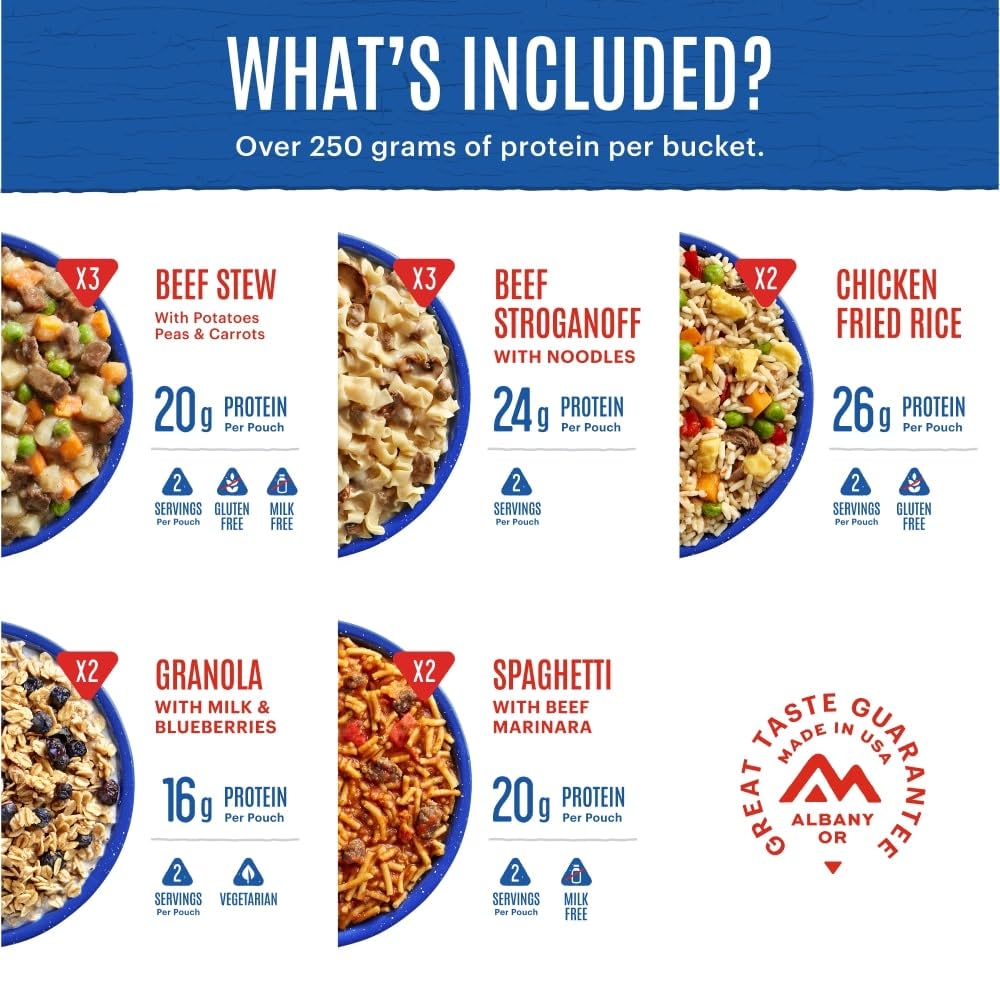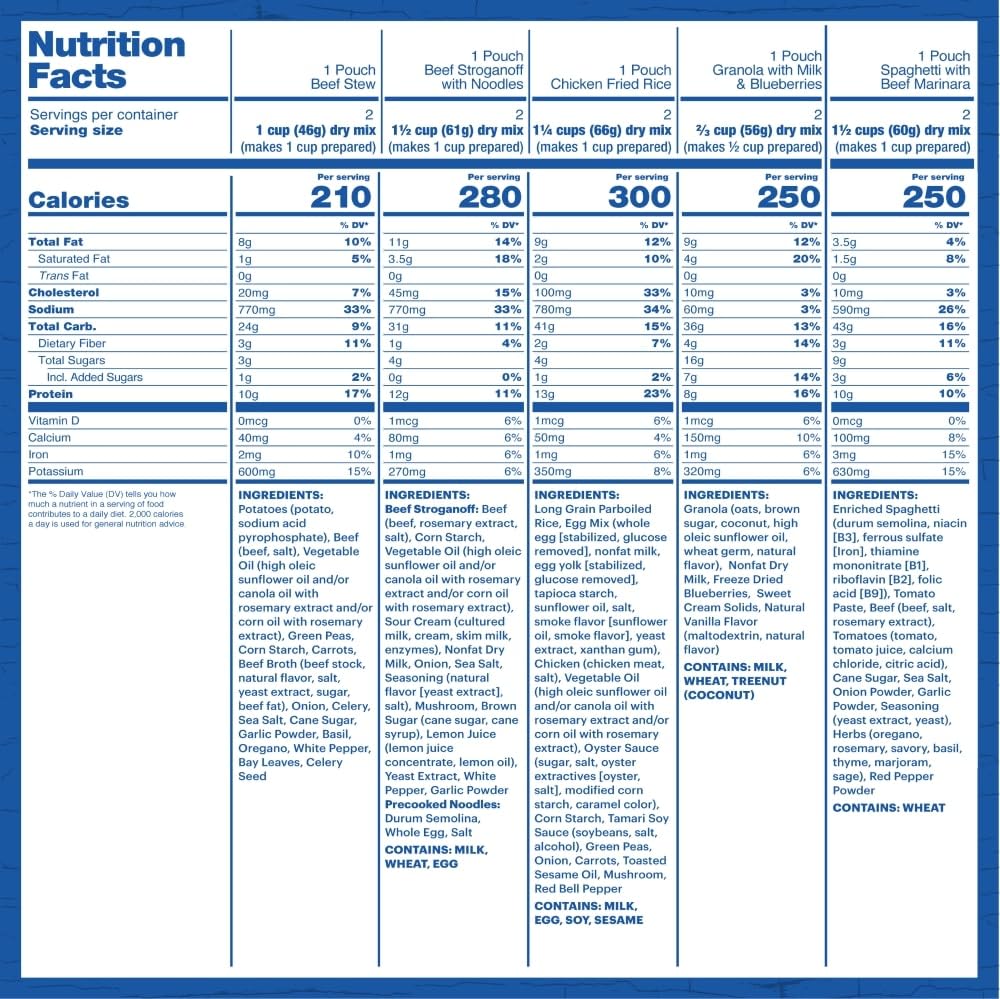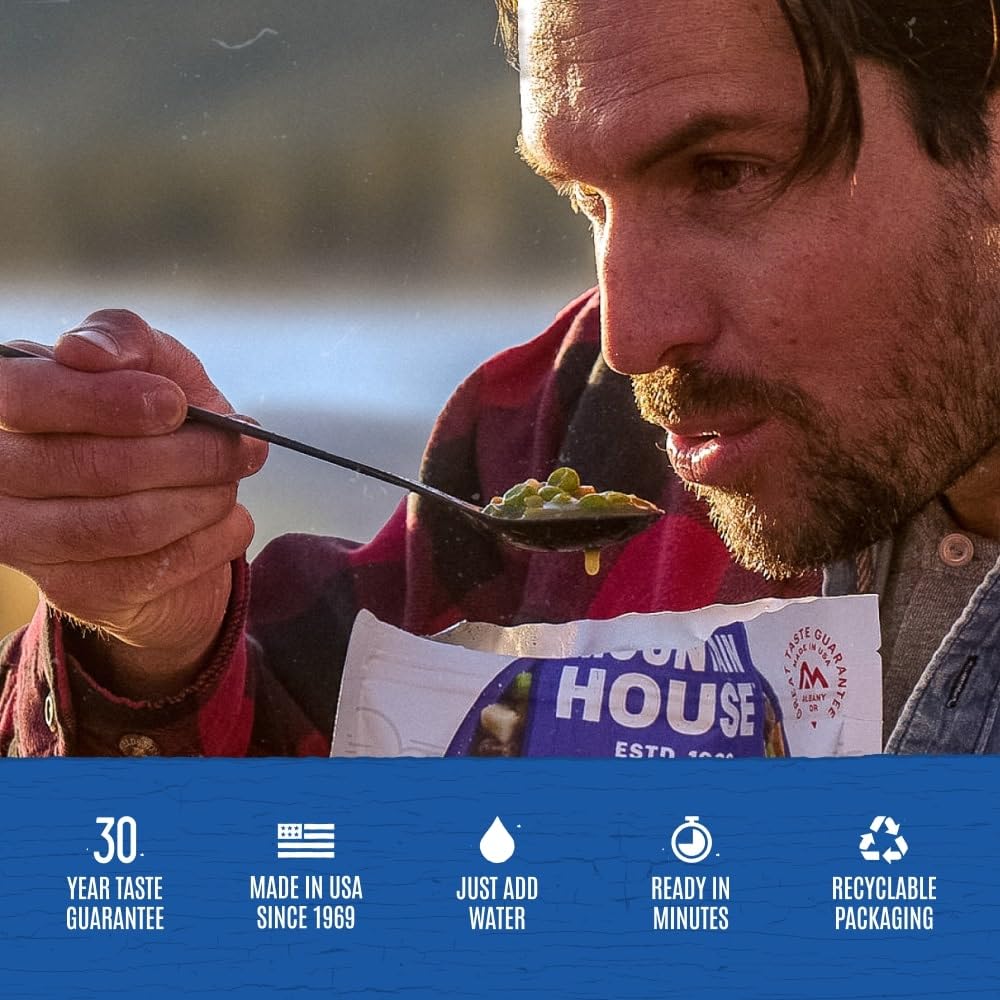
Mountain House Classic Meal Assortment Buying Guide Review
Mountain House Classic Meal Assortment Buying Guide Review
Imagine you’re miles from civilization, nestled under a canopy of stars after a long day of hiking. Your stomach rumbles, but there’s no restaurant in sight. This is where the magic of Mountain House meals comes in. More than just convenience food, they’re a reliable source of sustenance and a comforting taste of “home” in the great outdoors. Whether you’re a seasoned backpacker, a prepper stocking up for emergencies, or simply looking for a quick and easy meal solution, Mountain House’s Classic Meal Assortment offers a variety of flavors designed to satisfy and energize. This buying guide and review will delve into the details of these assortments, exploring what makes them a top choice for adventurers and homebodies alike.
Unpacking the Appeal of Mountain House Classic Meal Assortments
What exactly makes Mountain House such a popular choice for freeze-dried meals? It boils down to a combination of factors: taste, convenience, shelf life, and nutritional value. For many, the taste is the primary draw. Let’s face it, no one wants to choke down bland, unappetizing food, especially when relying on it for energy during strenuous activities or in stressful situations. Mountain House has spent decades refining its recipes to deliver meals that are not only palatable but genuinely enjoyable. The Classic Meal Assortment, in particular, focuses on crowd-pleasing dishes like Chicken Fried Rice, Beef Stroganoff, and Biscuits & Gravy. These aren’t exotic or overly adventurous flavors; they’re comfort foods designed to provide a sense of familiarity and satisfaction when you need it most. This predictability is a huge selling point for many users. Imagine knowing exactly what you’re getting – a reliable and tasty meal, every single time. The freeze-drying process plays a crucial role in preserving the flavor and nutritional content of the ingredients. It removes virtually all the moisture, preventing spoilage and locking in the essential nutrients that would otherwise degrade over time. The result is a meal that tastes remarkably fresh, even years after it was packaged. In the world of survival and emergency preparedness, this long shelf life is invaluable.
Beyond taste, the convenience of Mountain House meals is undeniable. They require minimal preparation – simply add hot water, wait a few minutes, and you’re ready to eat. This is especially advantageous when you’re camping, backpacking, or in a situation where cooking facilities are limited or non-existent. No pots, pans, or extensive cleanup required. Just a spoon and a hungry appetite. The lightweight packaging further enhances the convenience factor. The meals are designed to be compact and easy to carry, making them ideal for backpacking trips where every ounce counts. This also makes them easy to store in emergency kits or pantries without taking up excessive space. And speaking of nutritional value, Mountain House recognizes that their meals often serve as a primary source of fuel for outdoor activities or as a reliable source of nutrition during emergencies. That’s why they strive to provide a balanced blend of carbohydrates, protein, and fats in their meals to keep you energized and sustained. While not intended to be a substitute for a balanced diet in the long term, they are a nutritionally sound option for short-term use or in situations where access to fresh food is limited. Consider a scenario: you’re on a multi-day hike, and your energy is flagging. A quick and easy Mountain House meal can provide the boost you need to keep going, without weighing you down with heavy cooking gear or perishable ingredients. This combination of taste, convenience, shelf life, and nutritional value is what solidifies Mountain House’s position as a leader in the freeze-dried meal industry. Looking for a quick breakfast on the trail? The convenience of Mountain House Biscuits and Gravy is hard to beat.
Dissecting the Classic Meal Assortment Varieties
Mountain House offers several variations of their Classic Meal Assortment, each designed to cater to different preferences and dietary needs. Understanding the differences between these assortments is crucial for choosing the one that’s right for you. One common option is the standard “bucket” assortment, which typically contains a selection of their most popular meals, such as Chicken Fried Rice, Beef Stroganoff, Granola with Milk & Blueberries, and Macaroni and Cheese. These buckets are designed for long-term storage and emergency preparedness, offering a shelf life of up to 30 years. They’re a great option for families looking to build a food storage supply or for individuals who want to have a reliable source of food on hand in case of a disaster. Another popular variation is the “pouch” assortment, which comes in individual meal pouches. These are ideal for backpacking trips or for individuals who want to try a variety of flavors without committing to a large bucket. Pouch assortments often include a mix of breakfast, lunch, and dinner options, providing a complete meal solution for outdoor adventures. Within the pouch assortments, you may find variations tailored to specific dietary needs. For example, Mountain House offers gluten-free and vegetarian assortments, catering to individuals with dietary restrictions or preferences. These assortments typically contain meals that are free from gluten or animal products, respectively. When selecting a Classic Meal Assortment, it’s important to carefully review the menu to ensure that it aligns with your taste preferences and dietary requirements. Pay attention to the ingredients list and nutritional information to make an informed decision. Also, consider the number of servings provided in each assortment. Buckets typically contain multiple servings of each meal, while pouches usually contain single or double servings. Choose an assortment that provides enough food for your intended use. Thinking of venturing into the backcountry? Mountain House Chicken Fried Rice is a great choice for a filling meal after a day of hiking.
| Assortment Type | Typical Contents | Shelf Life | Serving Size | Ideal For |
|---|---|---|---|---|
| Bucket Assortment | Variety of Classic Meals (e.g., Chicken Fried Rice, Beef Stroganoff) | Up to 30 years | Multiple Servings per Meal | Emergency Preparedness, Long-Term Storage |
| Pouch Assortment | Individual Meal Pouches (Breakfast, Lunch, Dinner) | Up to 30 years | Single or Double Servings per Pouch | Backpacking, Camping, Individual Meals |
| Gluten-Free Assortment | Gluten-Free Meal Options | Up to 30 years | Single or Multiple Servings (depending on format) | Individuals with Gluten Intolerance |
| Vegetarian Assortment | Vegetarian Meal Options | Up to 30 years | Single or Multiple Servings (depending on format) | Vegetarians |
The packaging of these assortments also varies. Bucket assortments typically come in durable, airtight buckets that protect the meals from moisture and pests. These buckets are designed to be stackable, making them easy to store in a pantry or garage. Pouch assortments, on the other hand, come in individual, resealable pouches that are lightweight and compact. These pouches are designed to be tear-resistant and waterproof, ensuring that the meals remain fresh and protected during outdoor adventures. When comparing different Classic Meal Assortments, it’s helpful to read reviews from other users to get a sense of their experiences with the taste, texture, and overall quality of the meals. Online retailers and outdoor gear websites often feature customer reviews that can provide valuable insights. Consider factors such as the ease of preparation, the accuracy of the serving size information, and the overall satisfaction with the taste and texture of the meals. Some users may find certain flavors more appealing than others, so it’s helpful to get a range of opinions before making a decision. Ultimately, the best Classic Meal Assortment for you will depend on your individual preferences, dietary needs, and intended use. By carefully considering the different options available and reading reviews from other users, you can choose an assortment that will provide you with a reliable and tasty source of nutrition for years to come. Nothing beats a piping hot bowl of Mountain House Beef Stroganoff after setting up camp in the cold rain.
A Deep Dive into Preparation and Palatability
While the concept of “just add water” seems straightforward, mastering the preparation of Mountain House meals can significantly enhance the dining experience. The key is understanding the nuances of water temperature and rehydration time. While the instructions typically call for boiling water, using slightly cooler water can prevent the meals from becoming overly mushy. Experiment with different water temperatures to find the sweet spot for your personal preference. Also, be mindful of the amount of water you add. Too much water can result in a watery and flavorless meal, while too little water can leave some of the ingredients underhydrated. Start with the recommended amount of water and adjust as needed based on your observations. Another important factor to consider is the rehydration time. While the instructions typically provide a recommended time, it’s often beneficial to let the meals sit for a few extra minutes to ensure that all the ingredients are fully rehydrated. Stirring the meal periodically during the rehydration process can also help to ensure even hydration. In terms of palatability, Mountain House meals are generally well-received, but there are a few things you can do to enhance the flavor even further. Adding a pinch of salt, pepper, or other spices can help to bring out the natural flavors of the ingredients. A squeeze of lemon juice or a dash of hot sauce can also add a welcome kick. For those with dietary restrictions, there are several ways to customize Mountain House meals to meet their specific needs. For example, vegetarians can add extra vegetables to their meals to increase the nutritional value and fiber content. Gluten-free individuals can substitute gluten-free pasta or rice for the traditional ingredients. It is important to note that while some consider the long shelf life a plus, it can sometimes affect the texture. A common trick for freeze-dried foods that have been stored for long periods of time is to add a small amount of olive oil or butter during preparation to help reintroduce some moisture and improve the overall mouthfeel. This can be particularly helpful for meals that tend to dry out easily, such as rice dishes or pasta dishes. This can be done even without having a full kitchen.
The Mountain House Macaroni and Cheese is a dependable choice for pleasing even the pickiest eaters while in the wilderness. When comparing the palatability of different Mountain House meals, it’s helpful to consider the ingredients and flavor profiles. Some meals, such as the Chicken Fried Rice and Beef Stroganoff, are known for their savory and comforting flavors. Others, such as the Granola with Milk & Blueberries, are more sweet and refreshing. Choose meals that align with your personal taste preferences and the type of activity you’ll be engaging in. For example, a hearty and savory meal might be ideal for a cold weather backpacking trip, while a light and refreshing meal might be more appealing on a hot summer hike. Also, consider the nutritional content of the meals. Some meals are higher in protein, while others are higher in carbohydrates. Choose meals that provide the nutrients you need to fuel your activities. For example, a meal high in protein might be ideal for a strenuous workout, while a meal high in carbohydrates might be more beneficial for a long endurance event. Ultimately, the best way to determine the palatability of Mountain House meals is to try them for yourself. Purchase a variety of flavors and experiment with different preparation techniques to find the ones that you enjoy the most. Don’t be afraid to get creative and add your own personal touches to the meals to make them even more satisfying. With a little bit of experimentation, you can transform Mountain House meals from a convenient source of nutrition into a genuinely enjoyable dining experience, whether you’re in the backcountry or at home during an emergency. The taste of Mountain House Granola with Milk & Blueberries is a great way to start the day on a camping trip.
Real-World Applications and User Experiences
Mountain House meals aren’t just for backpackers and preppers. Their versatility makes them a practical choice for a wide range of situations. Consider the busy professional who often works through lunch. A quick and easy Mountain House meal can provide a nutritious and satisfying alternative to fast food or processed snacks. It’s a convenient way to fuel up and stay productive without sacrificing taste or quality. Similarly, parents of young children often find themselves short on time and energy. Mountain House meals can be a lifesaver on busy weeknights when there’s no time to cook a full meal. They’re a quick and easy way to provide a balanced and nutritious meal for the whole family. In the event of a natural disaster or emergency, Mountain House meals can be a critical source of sustenance. They require no cooking or refrigeration, making them ideal for situations where access to utilities is limited or non-existent. A well-stocked supply of Mountain House meals can provide peace of mind knowing that you and your family will have access to a reliable source of food in times of need. The long shelf life of Mountain House meals also makes them a practical choice for long-term storage. They can be stored in a pantry or garage for years without spoiling, providing a convenient and reliable source of food whenever you need it. This is especially beneficial for individuals who live in areas prone to natural disasters or for those who simply want to be prepared for any eventuality. Moreover, many users have shared their positive experiences with Mountain House meals in a variety of settings. Backpackers praise their lightweight packaging and ease of preparation, while preppers appreciate their long shelf life and nutritional value. Busy professionals value their convenience and taste, while parents appreciate their ability to provide a quick and nutritious meal for their families. These real-world applications and user experiences highlight the versatility and practicality of Mountain House meals. They’re not just for outdoor adventures or emergencies; they’re a convenient and reliable source of nutrition for a wide range of lifestyles and situations. Stocking up on a few Mountain House meals is a wise choice for anyone who values convenience, nutrition, and peace of mind.
Beyond the practical applications, Mountain House meals also offer a sense of comfort and familiarity. For many, the taste of a favorite Mountain House meal can evoke memories of past adventures or provide a sense of normalcy in stressful situations. This emotional connection can be particularly valuable in times of uncertainty or hardship. The positive user experiences extend beyond just the convenience and taste of the meals. Many users also appreciate the company’s commitment to quality and sustainability. Mountain House uses high-quality ingredients and sustainable packaging practices to minimize its environmental impact. This commitment to sustainability resonates with many environmentally conscious consumers who are looking for products that align with their values. Furthermore, the Mountain House community is a vibrant and supportive network of outdoor enthusiasts and preppers. Online forums and social media groups provide a platform for users to share their experiences, tips, and recipes. This sense of community can be invaluable for individuals who are new to backpacking or emergency preparedness. For example, someone new to backpacking might ask for recommendations on which Mountain House meals are best for a specific type of trip. Or, someone preparing for a natural disaster might ask for advice on how to store and rotate their Mountain House meals. This sense of community can help individuals feel more confident and prepared for whatever challenges they may face. In conclusion, the real-world applications and user experiences of Mountain House meals demonstrate their versatility, practicality, and emotional value. They’re more than just a convenient source of nutrition; they’re a reliable companion for outdoor adventures, a comforting source of food in emergencies, and a symbol of community for those who value preparedness and sustainability. Trying to pack light? The Mountain House Classic Meal Assortment is a great option.
Frequently Asked Questions (FAQ)
What is the shelf life of Mountain House Classic Meal Assortments?
Mountain House meals are renowned for their exceptional shelf life. The meals are freeze-dried and sealed in airtight packaging, which removes moisture and prevents spoilage. Under optimal storage conditions – cool, dry places are ideal – Mountain House meals can last for up to 30 years. This extended shelf life makes them a popular choice for emergency preparedness kits, long-term food storage, and situations where access to fresh food is limited. However, it’s important to note that while the meals are designed to last for decades, the quality and flavor may gradually diminish over time. While still safe to eat after many years, it’s recommended to rotate your stock and consume older meals first to ensure the best possible taste and texture. When storing Mountain House meals, avoid exposure to extreme temperatures and direct sunlight, as these can accelerate the degradation process. Regularly check the packaging for any signs of damage or leakage, and discard any meals that show signs of spoilage. Even if the packaging is intact, it’s a good idea to give the meal a sniff before consuming it after many years; if it smells rancid or “off,” it’s better to be safe than sorry.
How do you prepare Mountain House Classic Meal Assortments?
Preparing Mountain House meals is incredibly simple, which is a major part of their appeal. The process typically involves just a few steps: open the pouch or container, add boiling water (the amount is specified on the packaging), stir thoroughly, reseal the pouch, and wait for a designated time (usually 8-10 minutes) to allow the meal to rehydrate. Once the waiting period is over, simply open the pouch again, stir, and enjoy! While boiling water is generally recommended for optimal rehydration, you can also use hot water that is just below boiling. This may result in a slightly softer texture, which some users prefer. If you’re in a situation where hot water is not available, you can even use cold water, but the rehydration time will be significantly longer (potentially several hours). When adding water, be sure to pour it directly into the pouch to avoid making a mess. If you’re using a bucket assortment, you’ll need to transfer the contents to a separate container before adding water. After adding the water, stir thoroughly to ensure that all the ingredients are evenly hydrated. Be careful when handling the hot pouch or container to avoid burns. In the end, the simplicity of the preparation is one of the biggest draws of Mountain House meals. No cooking skills or equipment are needed. The ease of preparation makes them ideal for situations where you need a quick, no-fuss meal.
Are Mountain House meals nutritionally balanced?
Mountain House meals strive to provide a balance of essential nutrients, including carbohydrates, protein, and fats. They are designed to be a source of energy and sustenance in situations where access to fresh food is limited. While the specific nutritional content varies depending on the meal, Mountain House meals generally offer a reasonable amount of calories and protein to fuel your body during outdoor activities or emergencies. The meals also contain vitamins and minerals to support overall health and well-being. However, it’s important to note that Mountain House meals are not intended to be a substitute for a balanced diet in the long term. They may not provide all the micronutrients and fiber that you need to maintain optimal health. Additionally, some Mountain House meals may be high in sodium, so it’s important to be mindful of your sodium intake, especially if you have high blood pressure or other health conditions. When selecting Mountain House meals, it’s helpful to review the nutritional information on the packaging to ensure that they align with your dietary needs and preferences. You can also supplement your Mountain House meals with fresh fruits, vegetables, and other nutrient-rich foods to create a more balanced and complete diet. Keep in mind, a freeze dried meal isn’t meant to be the healthiest thing you can eat, but rather the most reliable and shelf stable in emergency situations.
Are Mountain House meals suitable for vegetarians or individuals with dietary restrictions?
Mountain House offers a variety of meal options to cater to different dietary needs, including vegetarian and gluten-free assortments. These assortments contain meals that are specifically formulated to exclude animal products or gluten, respectively. When selecting Mountain House meals, it’s important to carefully review the ingredients list to ensure that they meet your specific dietary requirements. Pay attention to potential allergens, such as dairy, soy, or nuts, if you have any food allergies. While Mountain House offers vegetarian and gluten-free options, it’s important to note that their production facilities may not be completely free from cross-contamination. If you have severe allergies or intolerances, it’s best to contact Mountain House directly to inquire about their allergen control procedures. In addition to vegetarian and gluten-free options, Mountain House also offers meals that are low in sodium or fat, catering to individuals with specific health concerns. You can also modify Mountain House meals to suit your dietary needs by adding your own ingredients. For example, you can add extra vegetables or protein to vegetarian meals or substitute gluten-free pasta or rice for the traditional ingredients. Always be sure to read the label carefully to avoid consuming something that causes a negative reaction.
How do I store Mountain House Classic Meal Assortments properly?
Proper storage is crucial for maximizing the shelf life and quality of Mountain House meals. The most important factors to consider are temperature, moisture, and light. Mountain House meals should be stored in a cool, dry place away from direct sunlight. The ideal temperature range is between 50°F and 70°F (10°C and 21°C). Avoid storing Mountain House meals in areas that are prone to temperature fluctuations, such as attics or garages. Moisture is another major enemy of freeze-dried foods. Ensure that the meals are stored in a dry environment to prevent the packaging from becoming damaged or the food from absorbing moisture. If you live in a humid climate, consider storing the meals in airtight containers with desiccant packets to absorb any excess moisture. Direct sunlight can also degrade the quality of Mountain House meals. Store the meals in a dark place or use opaque containers to shield them from sunlight. In addition to temperature, moisture, and light, it’s also important to protect Mountain House meals from pests. Store the meals in sealed containers to prevent rodents and insects from gaining access. Regularly inspect your stored meals for any signs of damage or infestation. With proper storage, Mountain House meals can last for decades, providing you with a reliable source of food in emergencies or for long-term storage.
Are Mountain House meals expensive compared to other options?
The cost of Mountain House meals can vary depending on the assortment type, the number of servings, and the retailer. Compared to some other freeze-dried meal options, Mountain House meals may be slightly more expensive. However, many users believe that the higher price is justified by the superior taste, quality, and shelf life of Mountain House meals. When evaluating the cost of Mountain House meals, it’s important to consider the long-term value they provide. The meals can last for up to 30 years, making them a cost-effective option for emergency preparedness or long-term food storage. Additionally, the convenience and ease of preparation of Mountain House meals can save you time and effort in the kitchen. Compared to eating out or ordering takeout, Mountain House meals can be a more affordable option, especially for individuals who are looking for a quick and nutritious meal. You can also save money by purchasing Mountain House meals in bulk or by taking advantage of sales and discounts. Many retailers offer discounts on Mountain House meals during outdoor gear sales or emergency preparedness events. Ultimately, the value of Mountain House meals depends on your individual needs and priorities. If you prioritize taste, quality, and long-term value, then Mountain House meals may be a worthwhile investment. On the other hand, if you are primarily concerned with price, you may want to consider other freeze-dried meal options. Remember to factor in the value of convenience and the potential cost savings of having a readily available meal option on hand.
Can I recycle the packaging of Mountain House Classic Meal Assortments?
The recyclability of Mountain House meal packaging can vary depending on the specific type of packaging and the recycling facilities in your area. Mountain House is committed to sustainability and is continuously working to improve the recyclability of its packaging. Some of their packaging components, such as the plastic pouches, may be recyclable in some areas. Check the packaging for recycling symbols or contact your local recycling center to determine if they accept the specific type of plastic used in Mountain House meal pouches. However, it’s important to note that the multi-layered construction of some Mountain House packaging may make it difficult to recycle in all areas. The packaging is designed to be durable and airtight to protect the meals from moisture and spoilage, which can make it challenging to separate the different materials for recycling. Even if the packaging is not recyclable, you can still reduce your environmental impact by properly disposing of it. Dispose of the packaging in a designated trash receptacle and avoid littering. You can also explore alternative uses for the empty packaging, such as using it to store small items or as a liner for trash cans. By properly disposing of or repurposing Mountain House meal packaging, you can help to minimize your environmental footprint. Many people save them for storing small electronics in their bags, where they can be kept dry and free from dust. Consider also contacting Mountain House directly to inquire about their sustainability initiatives and future plans for improving the recyclability of their packaging.





Price: $134.49 - $99.99
(as of Sep 13, 2025 07:32:19 UTC – Details)




